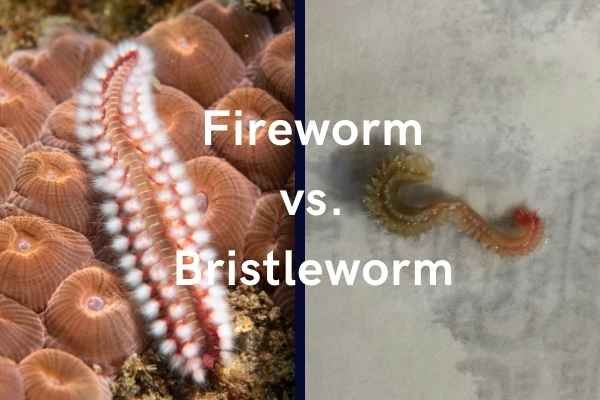
What Are Bristle Worms?
Bristle worms are a group of segmented worms belonging to the class Polychaeta. These creatures thrive in many marine environments, often living in sandy or muddy substrates. Imagine them as the cleanup crew of the ocean; they munch on detritus and plankton, contributing to a balanced ecosystem. You might find them in aquariums or tidal pools, typically visible at night when they come out to feed.
Visually, bristle worms can vary in size but usually have a long, slender, and segmented body. They often display a range of colors, from dull browns to bright hues, which can be an interesting addition to your aquarium. You can easily spot them by their bristles, or setae, that protrude from each segment. These bristles help them move around but can also cause mild irritation if you handle them.
In terms of behavior, bristle worms are generally harmless to humans and pets unless provoked. They prefer to stay hidden during the day, coming out only at night. If you’re worried about your aquarium, note that they often indicate a healthy environment, as they thrive on organic waste.
What Are Fireworms?
Now, let’s talk about fireworms. These creatures are also polychaetes but belong to the family Amphinomidae. While they play some role in marine ecosystems, they’re better known for their painful sting, which can feel like a burn—hence the name “fireworm.” When these worms feel threatened, they release irritants from their bristles, leading to discomfort for anyone who touches them.
Typically, fireworms are thicker than bristle worms and can grow quite large—some reaching up to 12 inches long! Their bodies are often more robust and possess colorful, vibrant bristles that can be distinctly sharp. These worms often have a reddish or brownish hue, making them stand out in the murky waters where they like to dwell.
Caution is key when it comes to fireworms. They don’t actively seek out confrontation, but if you accidentally disturb one, its bristles can deliver a painful sting. While not deadly, a fireworm sting can cause swelling, redness, and a burning sensation. If you encounter one, it’s best to just admire it from a safe distance!
Key Differences Between Fireworms and Bristle Worms
Now that we have a basic understanding of both creatures, let’s look at how to distinguish them. Here’s a quick overview of key differences:
- Appearance: Bristle worms tend to be slender and longer, while fireworms are generally thicker and more robust.
- Coloration: Bristle worms come in various colors, whereas fireworms usually exhibit vibrant red or brown hues.
- Bristles: Bristle worms have soft bristles that are relatively harmless, while fireworms possess sharp, stinging bristles.
- Behavior: Bristle worms are more docile and prefer to hide, while fireworms can be defensive if threatened.
Knowing these differences can be tremendously helpful, especially if you’re exploring coastal areas or maintaining an aquarium. Misidentification can lead to unnecessary fear or pain, so it’s worthwhile to commit these features to memory.
Where Do You Find Fireworms and Bristle Worms?
If you’re curious about where you might encounter these creatures, let’s outline their habitats. Bristle worms often inhabit sandy substrates and coral reefs, thriving on decomposing matter. They can also be found in estuaries and tidal pools, where they contribute to the nutrient cycling of the ecosystem.
On the other hand, fireworms prefer rocky areas, coral reefs, and seagrass beds. They often seek shelter in crevices or under coral, making them a bit tricky to spot. Fireworms are also more likely to be found in environments that are rich in organic matter, so they sometimes appear in aquariums with excess waste.
Understanding where these worms live can give you a better idea of what to look for when exploring marine environments. Plus, it’s just a blast to observe all the fascinating life at play beneath the waves!
The Importance of Identifying Worms
Why does it matter if you can tell a fireworm from a bristle worm? Well, knowing the difference can help you avoid painful encounters and make informed decisions about your marine environment. For example, if you’re a reef keeper, recognizing which worms are beneficial can guide you in maintaining a balanced tank. Bristle worms can help with waste management, while fireworms should be monitored closely.
Additionally, being aware of fireworms can be crucial for safety. If you’re diving or snorkeling, knowing they’re in the waters can spare you from an unpleasant surprise. After all, nobody wants to end their ocean adventure with a nasty sting!
What to Do If You Encounter a Fireworm
If you find yourself face-to-face with a fireworm, the best course of action is to keep your distance. Admiring it from afar is the safest way to enjoy its beauty without risking harm. If you’re collecting marine specimens or performing maintenance on an aquarium, consider using gloves to protect your hands.
In case you do get stung, rinse the affected area with seawater (not fresh water!) to help alleviate the pain. Applying a cold pack can also soothe the sting. If the pain persists or worsens, it’s wise to seek medical advice. Remember, while fireworm stings are generally not life-threatening, your comfort is important!
In the grand scheme of the ocean, both bristle worms and fireworms play their unique roles. While bristle worms help in cleaning and maintaining healthy environments, fireworms add to the complexity of marine life—albeit with a bit of caution. By being able to identify these creatures, you’re better equipped to appreciate the biodiversity of our oceans and enhance your experience, whether in an aquarium or a snorkeling adventure.
So next time you spot one of these worms, you can appreciate its place in the ecosystem and know how to interact safely. Happy exploring!
